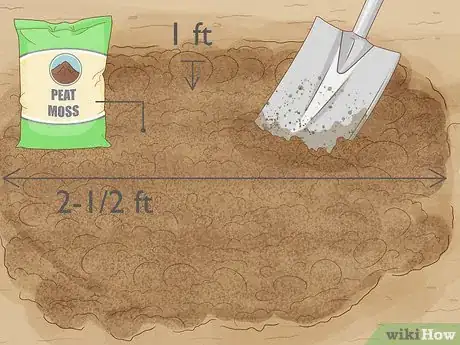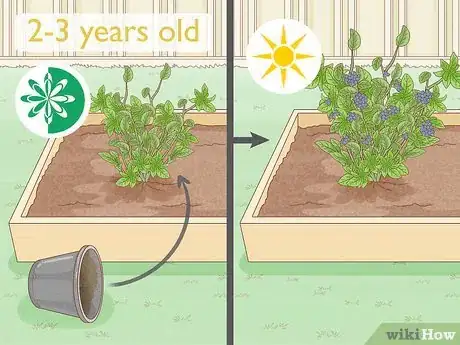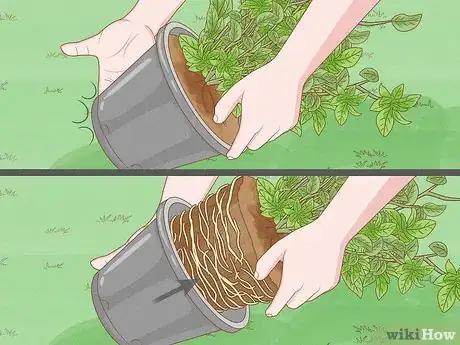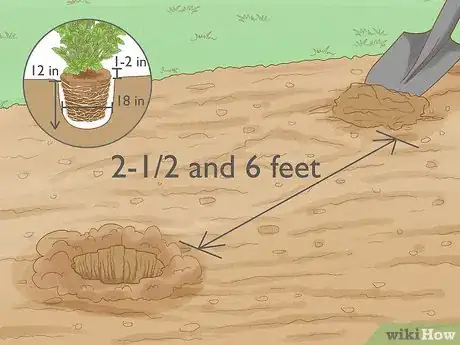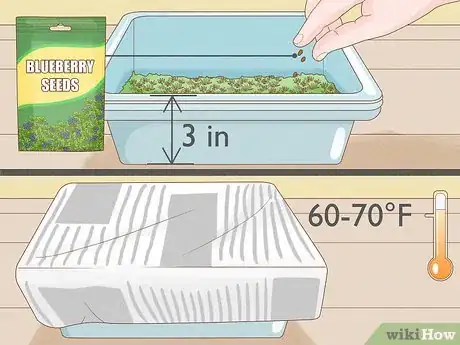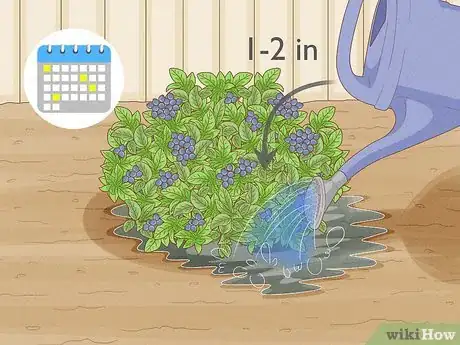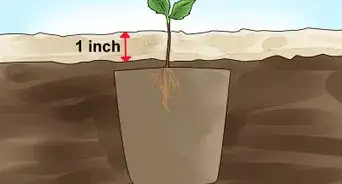This article was co-authored by Steve Masley. Steve Masley has been designing and maintaining organic vegetable gardens in the San Francisco Bay Area for over 30 years. He is an Organic Gardening Consultant and Founder of Grow-It-Organically, a website that teaches clients and students the ins and outs of organic vegetable gardening. In 2007 and 2008, Steve taught the Local Sustainable Agriculture Field Practicum at Stanford University.
This article has been viewed 111,642 times.
After buying blueberries at the store for so long, you may wonder how you can grow your own at home. It is easy to grow any of the three major varieties of blueberries in your backyard, depending on the climate you live in. Blueberry bushes are resistant to most pests and diseases and can produce fruit every summer for up to 20 years. Blueberries are extremely rich in healthy antioxidants, taste delicious, and look beautiful in your backyard.[1] To grow blueberries, start by choosing a blueberry variety. Then, prepare a spot in your yard to grow the blueberries and care for them properly once they start to grow.
Steps
Choosing a Blueberry Variety
-
1Choose highbush blueberries for a warm climate. This variety grows well in USDA hardiness zones four through seven. Highbush is the most common type of blueberry and it yields large, dark berries on bushes six to eight feet tall.
- Set highbush blueberries 6 feet (1.8 m) apart.
- This variety is best for eating fresh and for making desserts.
-
2Select lowbush blueberries for cold weather. This variety is resilient in cold weather and best for USDA plant hardiness zones two through six. This super-hardy variety grows low to the ground between 6 and 18 inches tall.
- Set lowbush blueberries 2 feet (0.6 m) apart.
- Lowbush berries are small and sweet. They are good for baking muffins and pancakes.
Advertisement -
3Go for rabbiteye bushes in a high heat climate. This variety does well in zones seven through nine and can tolerate heat and drought. The berries are typically smaller than highbush berries and they ripen a bit later in the summer than other varieties.
- Set rabbiteye blueberries 15 feet (4.6 m) apart.
- If you do not have a lot of space to plant your blueberries, maybe opt for the lowbush or highbush variety instead of the rabbiteye variety.
-
4Prepare for healthy pollination. Blueberries have both male and female organs on the same flower, but not all are self-pollinating. If you want to be sure that your blueberries will be pollinated, plant different varieties within 100 feet (30.5 m) of each other. Doing so allows bees to travel between plants and cross-pollinate.
Creating the Right Growing Conditions
-
1Build a raised garden bed in full sunlight. Fruit plants need as much sunlight as possible, especially when the berries begin to develop. Build a raised garden bed to grow your blueberries in. Blueberries do well in raised beds that are 3 to 4 feet (0.9 to 1.2 m) wide and 8 to 12 inches (20.3 to 30.5 cm) high. Make a simple raised garden box out of two 1 x 8-inch cedar boards. Cedar is a good choice for a garden bed because it won't rot with age.[2]
- Choose a high or raised spot in your garden for the garden beds. Avoid low-lying areas and spaces where water tends to collect and/or flood.
-
2Use peat moss in the soil. Mixing peat moss into the soil can improve drain, as peat moss can absorb and hold 10 to 20 times its dry weight in water. Use a planting area approximately 2-1/2 feet in diameter and 1 foot (0.3 m) deep. Remove no more than half of the soil and mix the removed soil with an equal ratio of peat moss. Mix the peat moss/soil mixture back into the planting area.
- Keep in mind peat moss can be harmful to the environment and is relatively expensive to buy. There are several environmental costs associated with the peat moss market, including the fuels required to dig drainage ditches, harrow and dry the peat, bale it, and ship it long distances.
-
3Check the pH of the soil. Most fruits do best in slightly acidic soil between a pH of 5.5 and 6.5. Blueberries prefer an even more acidic soil with a pH between 4.09 and 5.0.
- Your local agricultural extension office should have soil testing forms, bags and instructions available.
- If the pH level is higher than 5.0, enrich the soil to make it more acidic using acid compost or planting mix.
- If the soil pH is above 4.5, mix in granular sulfur to lower the pH level so it is closer to 4.09.
- After making adjustments to the soil, always test its pH level again.
Planting the Blueberries
-
1Use blueberry plants that are 2 to 3 years old. This way, they will start producing fruit for you quickly. If you start with younger plants, it will take a few years for them to develop fruit.
- Plant the bushes in early spring. The fruit will ripen toward the end of summer.
-
2Loosen the roots of the blueberry plants. Pat the blueberry plants with the heel of your wrist to loosen the roots. Do this all around the outside of the container and then turn it sideways and slide the plant out by tapping the bottom of the pot. Catch the plant with your hand.[3]
- Do not grab the plant by the stem as this can dislodge the roots and damage the plant.
-
3Dig a small hole for each plant. It should be shallow enough that the top of the root base is 1 to 2 inches (2.5 to 5.1 cm) above ground (for plants about 2 years old, 20 inches deep and 18 inches wide). You can use a simple hand trowel to dig the holes.[4]
- Make the holes between 2-1/2 and 6 feet apart. If you space the holes closer together, you will end up with continuous rows, but if you space the holes further apart, you will end up with individual bushes.
-
4Plant the blueberry plants. Pat soil up around the top of the plant to cover any exposed roots with 1⁄2 inch (1.3 cm) of soil. Then, add 2 to 4 inches (5.1 to 10.2 cm) of mulch to the planting side. This helps to keep the ground moist, prevent weeds, and enrich the soil.[5]
- Bark mulch, sawdust, and grass clippings are all good choices for mulch for blueberries. Replenish the mulch every couple of years.
- Always water the area thoroughly after planting.
-
5Grow blueberries from seed. If you do not want to use grown blueberry plants, you can grow blueberries from seed. Sow seed in a flat, 3-inch deep box filled with finely ground moist sphagnum moss. Keep the moss moist in a warm room between 60 and 70 degrees Fahrenheit and covered with a sheet of newspaper.[6]
- The seed should germinate into seedlings within one month. Place the seedlings in direct sunlight and continue growing them in the moss until they are about 2 to 3 inches (5.1 to 7.6 cm) tall. You can then transfer the seedlings to a larger pot or to your garden.
- Water the seedlings well and maintain them in a sunny location. After two to three weeks, fertilize the seedlings with liquid fertilizer at 1/2 the recommended rate.
Caring for Your Blueberry Plants
-
1Water the plants. Use one to two inches of water per week. Be careful not to over-water or drown your blueberry plants.[7]
-
2Prune the plants every winter. The first year that you plant the blueberries, clip all of the blooms off of the plants. This will allow the plants to become resilient before they start producing fruit. Pruning also removes crowded or stagnant stems and allows productive parts of the plants to grow stronger.[8]
- Every year thereafter, remove low growth around the base of the bush by clipping at an angle at the node of each branch. Remove any dead branches and/or twigs from the plants, as well as any discolored, blotchy growths.
- Prune lowbush blueberries by cutting the stems to ground level, but do not prune the full plant, as the pruned stems will not bear fruit the next season. To ensure your plant produces each year, only prune half of the plant each year.
- The pruning process should eliminate about 1/3 to 1/2 of the wood growth on each plant. Thin out the branches further if necessary.
EXPERT TIPPruning controls the growth and forces side shoots to develop. Over time, this creates a bushier, more stable plant.
Steve Masley has been designing and maintaining organic vegetable gardens in the San Francisco Bay Area for over 30 years. He is an Organic Gardening Consultant and Founder of Grow-It-Organically, a website that teaches clients and students the ins and outs of organic vegetable gardening. In 2007 and 2008, Steve taught the Local Sustainable Agriculture Field Practicum at Stanford University.
Steve Masley
Home & Garden Specialist Steve Masley
Steve Masley
Home & Garden Specialist -
3Fertilize the plants. If your blueberries grow less than a foot annually (or less than 4 inches for lowbush plants), try using a natural fertilizer to boost the plant's productivity. If possible, use an organic fertilizer to avoid hurting the roots and effectively deliver nitrogen to the blueberries.
- Seed meals such as soybean and alfalfa are good organic options. Use 1/4 cup to 2 cups of fertilizer per plant depending on the size.
- Blood meal and cottonseed meal also work well as fertilizer.
- Fertilize the plants in early spring and again in late spring for best results. Always water well after fertilizing.
-
4Test the pH level of the soil every two years. Remember, if the pH level is higher than 5.0, you can enrich the soil to make it more acidic using acid compost or planting mix. If the soil pH is above 4.5, mix in granular sulfur to lower the pH level.[9]
-
5Harvest your blueberries. Do this in late July or early August. Some varieties, including rabbiteye, take a bit longer to fully ripen. Each year, the time of harvest will vary slightly depending on climate conditions.[10]
Community Q&A
-
QuestionDo I need more than one bush to get berries?
 Community AnswerNo, but you get many more berries if you have more than one plant of the the same general category, such as high bush, low bush etc. Review the beginning of the article for details about the three types.
Community AnswerNo, but you get many more berries if you have more than one plant of the the same general category, such as high bush, low bush etc. Review the beginning of the article for details about the three types. -
QuestionCan i take a cutting or graft from a blueberry bush?
 DonaganTop AnswererYes. As with any woody plant, soak the cutting in liquid rooting hormone before planting. See FreePlants.com/HowToGrowBlueberryPlantsFromCuttings.html.
DonaganTop AnswererYes. As with any woody plant, soak the cutting in liquid rooting hormone before planting. See FreePlants.com/HowToGrowBlueberryPlantsFromCuttings.html. -
QuestionCan blueberries be cultivated in a greenhouse?
 DonaganTop AnswererYes, but they'll do much better out in the open.
DonaganTop AnswererYes, but they'll do much better out in the open.
References
- ↑ http://www.almanac.com/plant/blueberries
- ↑ http://www.almanac.com/content/raised-garden-beds-how-build
- ↑ http://www.almanac.com/plant/blueberries
- ↑ http://www.almanac.com/plant/blueberries
- ↑ http://www.almanac.com/plant/blueberries
- ↑ http://umaine.edu/blueberries/factsheets/home-garden/growing-blueberries-from-seed/
- ↑ http://www.almanac.com/plant/blueberries
- ↑ http://www.almanac.com/plant/blueberries
- ↑ http://www.rodalesorganiclife.com/garden/blueberries/slide/2
About This Article
To grow blueberries, plant a young blueberry plant in a raised garden bed that's in a sunny spot. Give your blueberry plant 1 to 2 inches of water per week and avoid overwatering it. To help your plant grow healthy and strong, fertilize it twice during the spring using an organic fertilizer. You'll also want to prune off all of the blooms on your plant during the first year to help make it stronger before it starts producing fruit. If you take the time to tend to your blueberry plant, you'll be able to harvest delicious blueberries in the summer! For tips on how to choose a blueberry variety to plant, read on!





